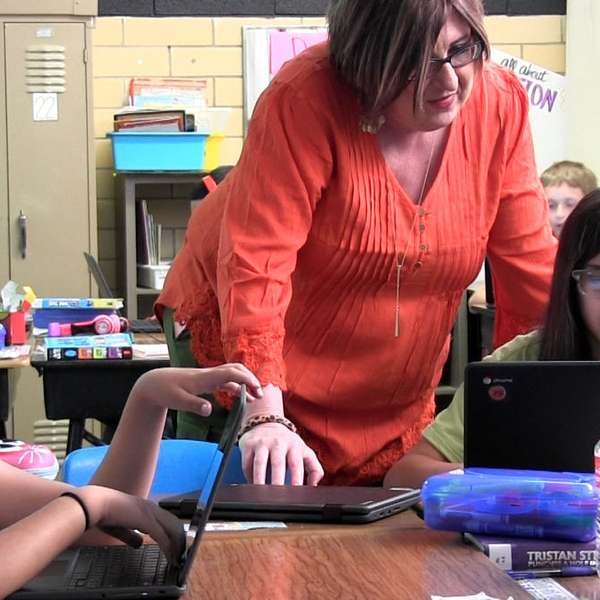
Opportunity Culture Audio
Opportunity Culture Audio
#6. Becoming a Committed Opportunity Culture School
Susan Hendricks was the principal of Ross Elementary in Ector County, Texas, before becoming the district’s director of leadership in August. Under her leadership, Ross Elementary received high ratings on the annual, anonymous survey given to Opportunity Culture educators. When we spoke with Hendricks earlier this year, she credited that success to having structures in place that the whole school understands and committing to the belief that the Opportunity Culture initiative is “who you are.”
Susan Hendricks: If you are going to do Opportunity Culture, commit. Jump in, make it who you are… and you have to make it the culture of your campus and the structure of what you do.
Sharon Kebschull Barrett: I’m Sharon Kebschull Barrett, and this is Opportunity Culture Audio.
In the annual, anonymous survey given to Opportunity Culture educators, Ross Elementary, in Odessa, Texas, received high ratings despite the stress of another Covid year. Ross’s principal, Susan Hendricks, an Opportunity Culture Fellow who just became the Ector County district’s director of leadership, told me that didn’t surprise her.
Hendricks: Because of the structures we have in place, that we put in place the first year. Even though maybe our—my—momentum, my momentum as the principal was off some, the structures still stayed the same, and the people here knew the structures, and they just kept going with it. And so, in that aspect, the momentum did not change, it was more of the personnel, like being available to meet every week. But it’s because of the structures that we have in place that are solid—and everybody understands their role, everybody understands what’s expected, and the whole school understands that everybody gets coached.
Barrett: So, how did she get everyone to understand the roles and expectations? Constant communication about the power of Opportunity Culture teams, Hendricks says.
Hendricks: One thing I think we’ve done very well here is we celebrate a lot. We do a lot of celebrations. So when we have data that’s big, we look at Opportunity Culture at its best. I mean, it’s—because that is our model, everything we do, I tie to Opportunity Culture. Growth, it’s all about growth, so when we came into this, growth and “together we’re better” was at the forefront of everything that we did, and it was just communicated constantly, and we just did a lot of celebrations—look at the growth, look at the team. Team, team, team, growth, growth, growth. Together, you know, look what we can do when we do things together as a team.
So I would say celebrations was huge, and tying those celebrations and the results to Opportunity Culture and the teamwork that’s being done. And I had just done a staff meeting, and we were looking at data, and I said, “This data is the result of y’all coming together as a team, being a professional learning community from the time you get here ’til the time that you leave. This is Opportunity Culture.” And it’s just those types of communications and tying in everything that you do to that.
You’ve gotta make it your culture. And the only way you do that is by highlighting it every chance you get. In writing, meetings, in just talking with teachers, you know, “What is your coach doing for you?”, “Look at that, wow, that’s amazing, you have value to give to your team.” And I think it has helped them see that they have true value because they’re growing.
Barrett: It helped, Hendricks says, that Opportunity Culture implementation at Ross had gone schoolwide, meaning it had multi-classroom leader teams in every grade.
Hendricks: Going schoolwide was easy for us because we just talked so much about it all the time— Opportunity Culture, like I said, has just become who we are. And so, it was a really easy adjustment, and we had new teachers down, “Wouldn’t you want an embedded all-day coach? Won’t that be awesome?” “ Yes, yes, yes!” And they loved it, and it’s just been great!
Barrett: That messaging is aided, she says, by being very careful during the selection process for multi- classroom leaders.
Hendricks: Well, they have to fit our vision and our culture. And it’s a team and we need to make sure that they are coachable, friendly, flexible, but yet, highly high-accountability and driven, and high expectations for everybody—themselves, their team members, and their students. And so, when you look for those qualities, then that’s the right fit for Ross Elementary.
Barrett: What Hendricks has learned that other principals should know, she says, is the importance of that message of “Opportunity Culture is who we are.”
Hendricks: If you are going to do Opportunity Culture, commit. Jump in, make it who you are, and you have to make it the culture of your campus and the structure of what you do.
Barrett: There’s real power, she says, in having Opportunity Culture roles be widespread early on, but again, focused communications will help if a school starts with just a few multi-classroom leaders.
Hendricks: So, if you start with one MCL, you can tie your celebrations to that, and then you have other people wanting to jump on board. I have people coming to me here on campus, and the money is a big part of it, you know, that is a great incentive. So, you could start with the one, and say, “This is what we’re doing” and talk about the pipeline—having those conversations often with your campus, that’s what I would do if I just started with one. So that we could grow. I want to grow my own—that would be the goal.
Barrett: Our thanks to Susan Hendricks for sharing her thoughts with us! To learn more, see OpportunityCulture.org.